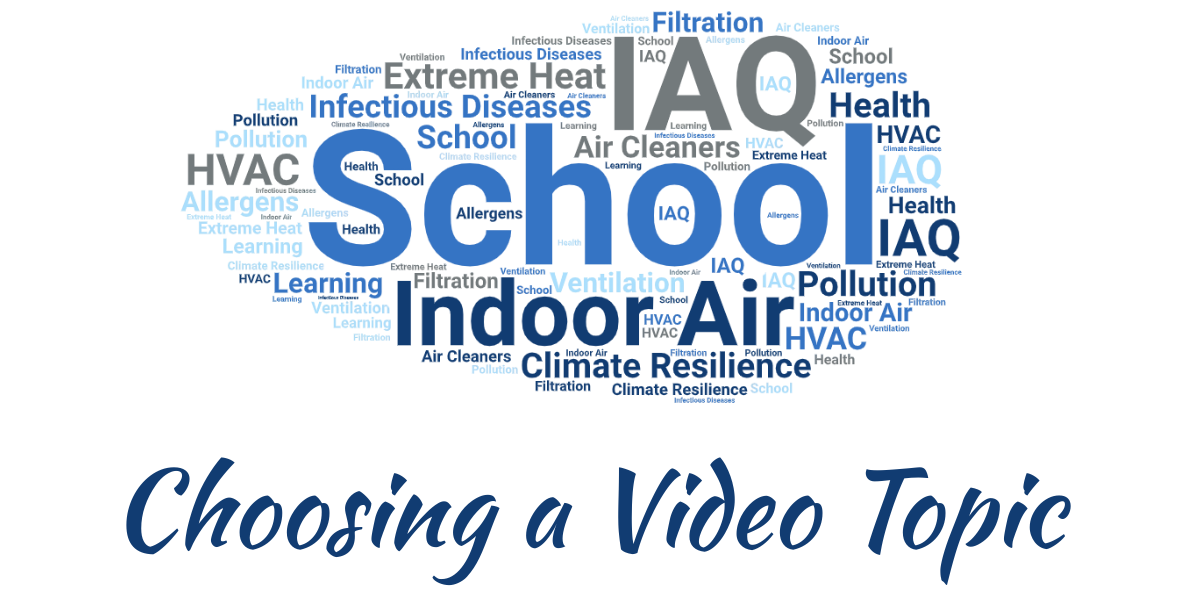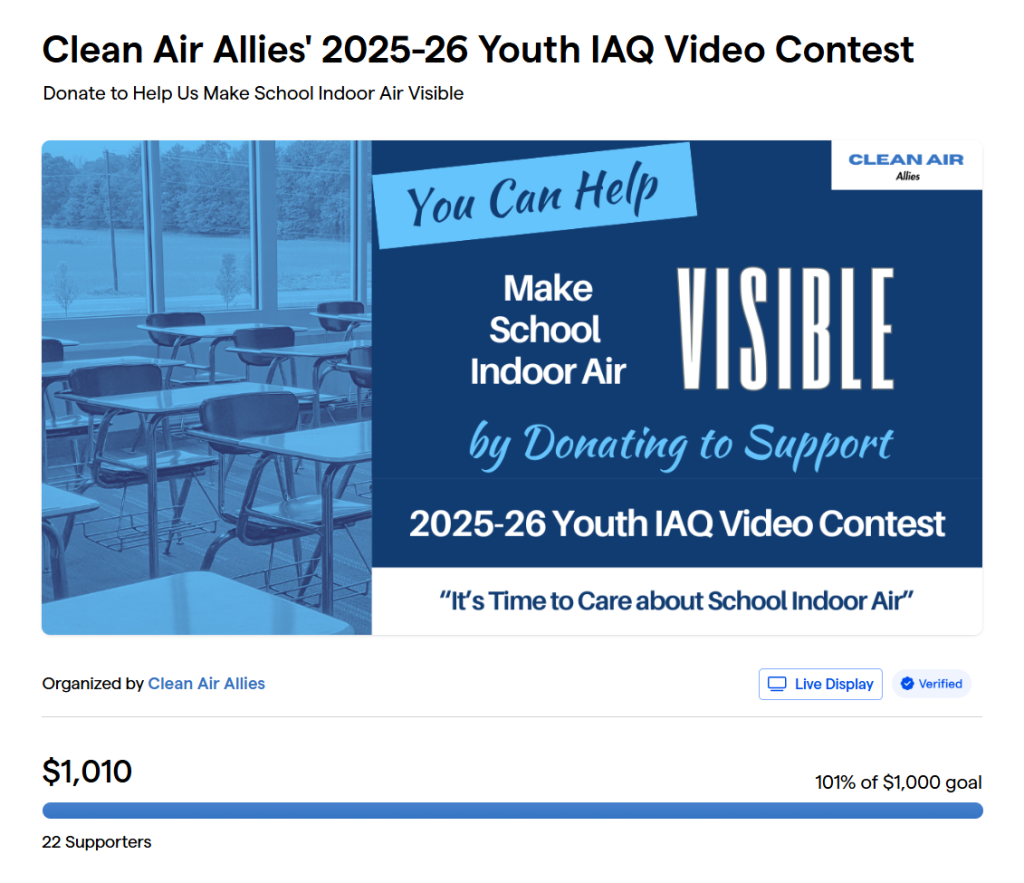
Clean Air Allies 2025-2026 Youth IAQ Video Contest:
It’s Time to Care about School Indoor Air
#CareAboutSchoolAir

Clean Air Allies, a nonprofit organization dedicated to improving access to clean indoor air in PK-12 schools, is launching a U.S. nationwide youth video contest. U.S. youths who are age 13 or older, and in Grades 9-12 during the 2025-2026 school year, are invited to create a 1 to 3-minute video around the theme It’s Time to Care about School Indoor Air and enter it in the contest.
The contest’s goals are to:
- amplify youth voices,
- help make school indoor air visible to more people, and
- raise awareness about why good indoor air quality (IAQ) in schools matters.
Benefits to youth contestants include:
- the opportunity to hone their research skills, showcase their creativity, and make their voices heard on a topic of major importance to health, learning, and climate resilience,
- the potential for recognition as one of 10 Contest Finalists, a merit-based honor that can be listed on college and scholarship applications, and
- the possibility of being awarded a First-, Second-, or Third-Place Prize of $500, $250, or $150 (cash-equivalent gift certificates) by a panel of guest judges.
Contest entries will be accepted between November 15, 2025, and January 12, 2026.
CONTEST OVERVIEW
2025-2026 Contest Theme:
- It’s Time to Care about School Indoor Air
Help Share the Contest:
- Sharing Toolkit
- #CareAboutSchoolAir
Contest Entries Accepted:
- 12:00 a.m. Pacific Time (PT) on November 15, 2025, through 11:59 p.m. Pacific Time (PT) on January 12, 2026
Contest Eligibility:
- Must be age 13 or older.
- Must be a citizen or permanent resident of the United States.
- Must be in Grade 9, 10, 11, or 12 during the 2025-2026 school year.
Contest Official Rules and Forms:
- Official Rules
- Contestant and Parental Consent Form
- Video Participant Consent Form
- Contest Submission Form
Contest Timeline:
- Contest entries must be submitted by 11:59 p.m. Pacific Time (PT) on January 12, 2026.
- 10 Contest Finalists will be selected by Clean Air Allies and its partners and announced by ~late February 2026.
- First-, Second-, and Third-Place Contest Winners will be selected by a panel of guest judges and announced by ~late March 2026.
Contest Prizes (cash-equivalent gift certificates):
- First-Place Contest Winner: $500 Prize
- Second-Place Contest Winner: $250 Prize
- Third-Place Contest Winner: $150 Prize
Contest Entry Requirements Summary:
- Review the Official Rules and Forms for the contest.
- Create one original 1 to 3-minute video about indoor air quality (IAQ) in Pre-Kindergarten to Grade 12 (PK-12) schools. The video should have 1080p resolution and be in .MP4 .MPEG, .MOV, .AVI, or .WMV file format, with a maximum file size of 500 MB.
- Obtain a completed Video Participant Consent Form for each person other than the contestant whose image or voice appears in the video.
- Complete the Contestant and Parental Consent Form.
- Make the video publicly accessible by uploading it to one or more of the following social media sites: YouTube, TikTok, Instagram, Facebook, Vimeo, LinkedIn, Pinterest, Rumble, Bluesky, or Twitter/X. The video may be posted using the Contestant’s account or the account of the Contestant’s Parent or Legal Guardian. Pseudonymous posting is allowed if permitted by the social media site, but the video must be publicly accessible—that is, not designated as private.
- Complete and submit the Contest Submission Form by the entry deadline, including a social media link for the video and uploads of the video file, Contestant and Parental Consent Form, and any required Video Participant Consent Forms.
Contest Judging:
- Only entries submitted by the contest deadline that are complete, accurate, and comply with the Official Rules are eligible to be judged.
- Clean Air Allies and its partners will select 10 Contest Finalists from among eligible entries.
- A panel of guest judges will select First-, Second-, and Third-Place Contest Winners from among the 10 Contest Finalists.
- Judging will consider:
- clarity and effectiveness in messaging;
- factual accuracy;
- visual appeal and production quality;
- creativity; and
- audience-appropriateness.
Questions about the Contest? Please contact info@cleanairallies.org.
Good Luck! We can’t wait to see your views on school IAQ!

Clean Air Allies doesn’t expect videos entered in the contest to tackle every school IAQ problem or solution.
Some contestants may choose to offer a broad overview of how school IAQ affects students, staff, and/or their communities. Others may choose to focus on increasing awareness around a specific school IAQ issue–for example, carbon monoxide–or solution–for example, installing HVAC to increase resilience against extreme heat. Both approaches are valid.
Contestants may also consider how school IAQ affects particular groups of individuals–for example, students and staff in schools close to major sources of pollution like busy roads–or on broad social costs–for example, school and work days missed due to acute and chronic respiratory conditions.
Clean Air Allies welcomes a variety of school IAQ-related topics, approaches, and voices.
What Is IAQ?
Clean Air Allies takes a holistic view of indoor air quality (IAQ) and associated problems and solutions. The Clean Air Allies factsheet Why Care about School Indoor Air? offers a good starting point.
IAQ has three main dimensions:
- Is inside air fresh—that is, is it regularly refreshed with air from outdoors?
- Is inside air clean from contaminants like germs, mold, particulate matter (PM), and allergens?
- Is inside air a healthy temperature and humidity?
Each dimension involves different problems and solutions.
Starting Questions to Ask in Deciding on a Video Topic and Approach
Below are some questions to ask while brainstorming a video topic. The next section highlights some reputable sources that may help with research to further develop the topic.
1. What school IAQ issues am I most interested in or concerned about?
Examples might include:
- how pollutants in indoor school air (whether originating indoors or outdoors) affect physical and mental health and learning
- how school indoor air is related to infectious disease transmission and associated illness, medical costs, missed school and work days, and lost learning
- the dangers of not increasing school resilience against wildfire smoke
- the effects of more extreme temperatures on schools
- what carbon dioxide (CO2) levels tell us about school indoor air
- whether policymakers are doing enough to ensure that indoor air in schools is safe and healthy
2. What solutions to school IAQ issues do I find most interesting or promising?
Examples might include:
- educating people about how IAQ generally affects health and learning in schools
- educating people about how poor IAQ puts specific groups at risk–for example, students and staff with asthma, compromised immunity, or other chronic health conditions
- limiting indoor sources of pollution–for example, by using less toxic cleaning products
- limiting outdoor sources of pollution–for example, by adopting no-idling policies
- installing heating, ventilation, and air conditioning (HVAC) systems in schools that don’t have them
- assessing, better maintaining, or upgrading existing school HVAC systems
- using portable air cleaners to remove germs, pollutants, and allergens from classroom air
- adopting better protocols for how schools deal with air pollution from wildfires
- using sensors/monitors to track CO2, CO, PM2.5, bioaerosols, etc. in classroom air
- opening doors and windows when CO2 levels get too high
- designing schools and schoolyards to improve indoor air quality
- setting and ensuring healthy and safe temperature ranges in schools
- better enforcing existing laws related to school IAQ
- creating new laws that set stricter IAQ standards for schools
3. What types of benefits can come from ensuring good IAQ in schools? For individuals? For particular groups of individuals? For entire communities? For society at large?
Examples might include:
- increased quality of life and avoided economic costs in relation to acute and chronic health conditions
- greater inclusiveness
- more comfortable learning environments
- better test scores
- improved resilience against climate-related impacts
4. What would I like to tell a friend, parent, teacher, principal, school district board member or administrator, or legislator (state or federal) about IAQ in schools?
Related questions:
- How would I help someone from this list learn more about school IAQ and why it matters? What evidence or arguments would they find most convincing?
- What would I want them to do with this knowledge–that is, what actions would I want them to take?

After initial brainstorming, research using reputable sources can help to further develop a video topic or approach, as well as identify relevant facts and statistics.
Sources from federal or state government agencies, research institutions, or reputable nonprofit organizations are a good place to learn more about IAQ and how it affects schools.
The following examples cover a wide variety of IAQ-related topics and represent a range of reputable sources. There’s no need to consult all of them. Of course, there are many other reputable sources that may be useful for particular video topics.
Why Care about School Indoor Air? Clean Air Allies
This 1-page fact sheet overviews IAQ in schools, why it matters, and steps that can be taken for healthier school indoor air.
IAQ Video Lessons, University of California at Davis (UC Davis) and California Department of Public Health (CDPH)
More than 30 short videos featuring leading academic experts cover a variety of IAQ problems and solutions.
The Importance of Filtration in Schools and The Importance of Ventilation in Schools, University of California at Davis (UC Davis) and the National Energy Management Institute (NEMI)
The first video explains what ventilation is, why it’s important for good IAQ, and how it can be improved in schools. The second video discusses airborne pollutants, how they get into classrooms, and what can be done about them.
Indoor Air Quality Tools for Schools, U.S. Environmental Protection Agency (EPA)
This webpage contains a wide array of EPA resources on school IAQ, ranging from research summaries to practical tips.
IAQ in Schools, Lawrence Berkeley Lab (LBL)
This webpage summarizes research related to different IAQ issues in schools (allergens, volatile organic compounds, particles, dampness and mold, and ventilation with outdoor air).
Changes in IEQ and Health Driven by Changes in the Outdoor Environment, Lawrence Berkeley Lab (LBL)
This webpage looks at research on how a changing climate and environment affects IAQ.
Improving Indoor Air Quality in Schools, California Department of Public Health (CDPH)
This guidance introduces why school IAQ matters and approaches to improving it.
Preventing Spread of Infections in K-12 Schools, U.S. Centers for Disease Control and Prevention (CDC)
This guidance explains how schools can “Take Steps for Cleaner Air” as an “everyday action” to “help prevent the spread of common childhood illnesses … and maximize school participation.”
Best Practices Guide for Improving Indoor Air Quality in Commercial/Public Buildings During Wildland Fire Smoke Events, U.S. Environmental Protection Agency (EPA)
This guide considers the dangers of indoor exposure to smoke, including children’s particular susceptibility. It also shows how to create a “Smoke-Ready Plan”: a “list of actions to take before, during, and after a smoke event.”
Toolkit to Address Extreme Heat on School Campuses, Los Angeles County Department of Public Health
This toolkit offers a holistic view of the issues presented by extreme heat events and suggests ways that schools can increase their resilience.
School IAQ Fact Sheets, American Society of Heating, Refrigerating and Air-Conditioning Engineers (ASHRAE) and the U.S. Green Building Council (USGBC)
These fact sheets survey different measures to improve school IAQ. They are brief, but quite technical.
Indoor Air Quality Resources, National Center for School Infrastructure (NCSI)
Dozens of resources relating to IAQ in schools are listed, including webinars, research papers, and fact sheets.

Clean Air Allies wants to thank the amazing donors who made the 2025-2026 Youth IAQ Video Contest possible by contributing to prizes. We’re proud to be part of a clean air movement. You can see our donors here.

